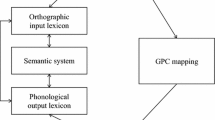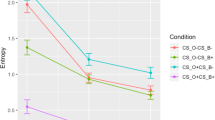Abstract
The present study was designed to assess the development of the understanding of certain aspects of grapheme-phoneme correspondences in normally achieving and disabled readers. The correspondences rules were studied using both English words and pseudowords, the latter designed to contain the same features as the real words. The subjects were 76 normally achieving and 32 reading disabled children aged 6 to 14 years. The stimuli included words and pseudowords that tested the following: consonant blends, final e, r-influenced vowels, regular and irregular words, function words, and consistent and inconsistent vowels. When matched for chronological age, the reading disabled children performed significantly more poorly than normally achieving children on all of the tasks involving pseudowords. A similar pattern was found for the words with the exception of the highest frequency words (cvc, final e, consonant blends) at the oldest age level, 11–14 years. In this case, the performance of the oldest reading disabled children was similar to that of the normals on the words, but was still significantly poorer when the stimuli were pseudowords. Complexity and irregularity were significant determinants of difficulty. Comparisons were also made for groups of children matched on reading grade level. Even when the reading disabled and normally achieving children were matched on reading grade, the reading disabled children had significantly more difficulty, particularly with pseudowords. Reading disabled children had significant difficulty in abstracting the basic rules for grapheme-phoneme correspondences in English, and even when they have mastered these rules in connection with real words, they still had difficulty applying these rules to pseudowords. In normal development, the learning of these correspondences appears to be consolidated by approximately 9 years of age. However, reading disabled children appear to have a significant and persistent problem with the learning of basic grapheme-phoneme correspondence rules.
Similar content being viewed by others
References
Backman, J., Bruck, M., Hebert, M. and Seidenberg, M. S. 1981. Acquisition and use of spelling sound correspondences in reading. Journal of Experimental Child Psychology, 38, 114–133.
Backman, J. E., Mamen, M. and Ferguson, H. B. 1984. Reading level design: Conceptual and methodological issues in reading research. Psychological Bulletin, 96, 560–568.
Bradley, L. and Bryant, P. 1981. Visual memory and phonological skills in reading and spelling backwardness. Psychological Research, 43, 193–199.
Bruck, M. 1982. McGill Decoding Test. McGill-Montreal Children's Hospital Learning Centre. 3640 Mountain St., Montreal, Quebec, Canada.
Bruskin, C. and Blank, M. 1984. The effects of word class and children's reading and spelling. Brain and Language, 21, 219–232.
Bryant, P. and Goswami, V. 1986. Strengths and weaknesses of the reading level design. A comment on Backman, Mamen, and Ferguson. Psychological Bulletin, 100, 101–103.
Calfee, R. C., Lindamood, P. and Lindamood, C. 1973. Acoustic-phonetic skills and reading-kindergarten through twelfth grade. Journal of Educational Psychology, 64, 293–298.
Dunn, L. M. and Dunn, L. M. 1981. Peabody Picture Vocabulary Test — Revised. Circle Pines, MN: American Guidance Service.
Ehri, L. C. 1975. Word consciousness in readers and prereaders. Journal of Educational Psychology, 67, 204–212.
Ehri, L. C. and Wilce, L. S. 1979. The mnemonic value of orthography among beginning readers. Journal of Educational Psychology, 71, 26–40.
Ehri, L. C. and Wilce, L. S. 1983. Development of word identification speed in skilled and less skilled beginning readers. Journal of Educational Psychology, 75, 3–18.
Guthrie, J. T. and Seifert, M. 1979. Letter sound complexity in learning to identify words. Journal of Educational Psychology, 69, 686–696.
Hogaboam, T. A. and Perfetti, C. A. 1978. Reading skills and the role of verbal experience in decoding. Journal of Educational Psychology, 70, 717–729.
Jastak, J. R. and Jastak, S. R. 1978. Wide Range Achievement Test. Wilmington, Delaware: Guidance Associates.
Mamen, M., Ferguson, H. B. and Backman, J. E. 1986. No difference represents a significant finding: The logic of the reading level design. A response to Bryant and Goswami. Psychological Bulletin, 100, 104–106.
Manis, F. R. 1986. Acquisition of word identification skills in normal and disabled readers. Journal of Educational Psychology, 77, 78–90.
Manis, F. R., Savage, P. L., Morrison, F. J., Horn, C. C., Howell, M. J., Szeszulski, P. A. and Holt, L. K. 1987. Paired associate rule learning in reading disabled children: Evidence for a rule learning deficiency. Journal of Experimental Child Psychology, 43, 25–43.
Perfetti, C. A. and Hogaboam, T. 1975. Relationship between single word decoding and reading comprehension skills, Journal of Educational Psychology, 67, 461–469.
Seidenberg, M. S., Bruck, M., Fornarolo, G. and Backman, J. 1985. Word recognition processes of poor and disabled readers: Do they necessarily differ? Applied Psycholinguistics, 6, 161–180.
Siegel, L. S. 1986. Phonological deficits in children with a reading disability. Canadian Journal of Special Education, 2, 45–54.
Siegel, L. S. and Ryan, E. B. 1988. Development of grammatical sensitivity, phonological, and short-term memory skills in normally achieving and learning disabled children. Developmental Psychology, 24, 28–37.
Snowling, M. J. 1980. The development of grapheme-phoneme correspondence in normal and dyslexic readers. Journal of Experimental Child Psychology, 29, 294–305.
Snowling, M. J. 1981. Phonemic deficits in developmental dyslexia. Psychological Research, 43, 219–234.
Steinhauser, F. and Guthrie, J. T. 1978. Reading ability and efficiency of graphemephoneme encoding. Journal of General Psychology, 99, 281–291.
Treiman, R. and Hirsh-Pasek, K. 1985. Are there qualitative differences in reading behavior between dyslexics and normal readers? Memory & Cognition, 13, 357–364.
Venezky, R. L. and Johnson, D. 1973. Development of two letter-sound patterns in grades one through three. Journal of Educational Psychology, 64, 109–115.
Waters, G. S., Bruck, M. and Seidenberg, M. 1985. Do children use similar processes to read and spell words? Journal of Experimental Child Psychology, 39, 511–530.
Wechsler, D. 1974. Manual for the Wechsler Intelligence Scale for Children — Revised. N.Y.: Psychological Corporation.
Author information
Authors and Affiliations
Rights and permissions
About this article
Cite this article
Siegel, L.S., Faux, D. Acquisition of certain grapheme-phoneme correspondences in normally achieving and disabled readers. Read Writ 1, 37–52 (1989). https://doi.org/10.1007/BF00178836
Issue Date:
DOI: https://doi.org/10.1007/BF00178836




